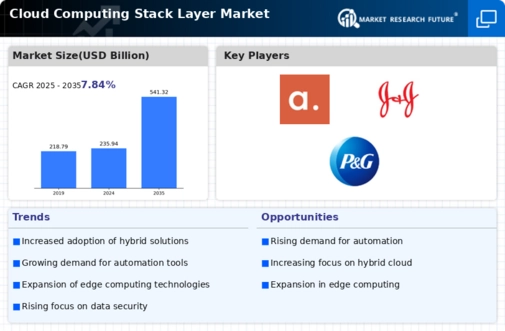Market Growth Projections
The Global Cloud Computing Stack Layer Market Industry is poised for substantial growth, with projections indicating a market size of 235.94 USD Billion in 2024 and an anticipated increase to 541.32 USD Billion by 2035. This growth trajectory reflects a compound annual growth rate (CAGR) of 7.84% from 2025 to 2035. Such figures underscore the increasing reliance on cloud solutions across various sectors, driven by the need for scalability, flexibility, and cost efficiency. As organizations continue to embrace digital transformation, the cloud computing market is likely to expand, presenting numerous opportunities for stakeholders.
Adoption of Hybrid Cloud Models
The Global Cloud Computing Stack Layer Market Industry witnesses a notable shift towards hybrid cloud models, which combine public and private cloud environments. This approach allows organizations to maintain control over sensitive data while leveraging the scalability of public clouds for less critical operations. The flexibility offered by hybrid solutions is appealing to enterprises aiming to optimize costs and enhance operational efficiency. As hybrid cloud adoption accelerates, the market is expected to grow significantly, potentially reaching 541.32 USD Billion by 2035, indicating a robust trajectory fueled by this strategic shift.
Emergence of Advanced Technologies
The Global Cloud Computing Stack Layer Market Industry is significantly influenced by the emergence of advanced technologies such as artificial intelligence and machine learning. These technologies enhance cloud capabilities, enabling organizations to derive actionable insights from vast data sets. As businesses increasingly adopt AI-driven solutions, the demand for cloud infrastructure that supports these technologies is likely to rise. This trend not only drives innovation but also fosters competitive advantages for organizations that effectively leverage cloud-based AI tools. The integration of advanced technologies is expected to play a crucial role in shaping the future landscape of the cloud computing market.
Regulatory Compliance and Data Security
In the Global Cloud Computing Stack Layer Market Industry, regulatory compliance and data security emerge as critical drivers. Organizations are increasingly mandated to adhere to stringent data protection regulations, necessitating the adoption of cloud solutions that ensure compliance. This trend is particularly pronounced in sectors such as healthcare and finance, where data breaches can have severe consequences. Cloud providers are responding by enhancing security measures and offering compliance certifications, thereby fostering trust among potential clients. This focus on security is likely to contribute to the market's growth as businesses prioritize safe cloud adoption.
Increasing Demand for Scalable Solutions
The Global Cloud Computing Stack Layer Market Industry experiences a surge in demand for scalable solutions, driven by the need for businesses to adapt to fluctuating workloads. Organizations increasingly seek cloud services that can seamlessly scale resources up or down based on real-time requirements. This trend is particularly evident in sectors such as e-commerce and finance, where transaction volumes can vary significantly. As a result, the market is projected to reach 235.94 USD Billion in 2024, reflecting a growing reliance on cloud infrastructure to support dynamic business environments.
Cost Efficiency and Resource Optimization
Cost efficiency remains a pivotal driver in the Global Cloud Computing Stack Layer Market Industry. Companies are increasingly recognizing the financial benefits of migrating to cloud-based solutions, which often reduce the need for extensive on-premises infrastructure. By leveraging cloud services, organizations can optimize resource allocation and minimize operational costs. This trend is particularly relevant for small and medium-sized enterprises that may lack the capital for substantial IT investments. As businesses continue to seek cost-effective solutions, the market is anticipated to grow at a CAGR of 7.84% from 2025 to 2035, reflecting the ongoing shift towards cloud adoption.















Leave a Comment